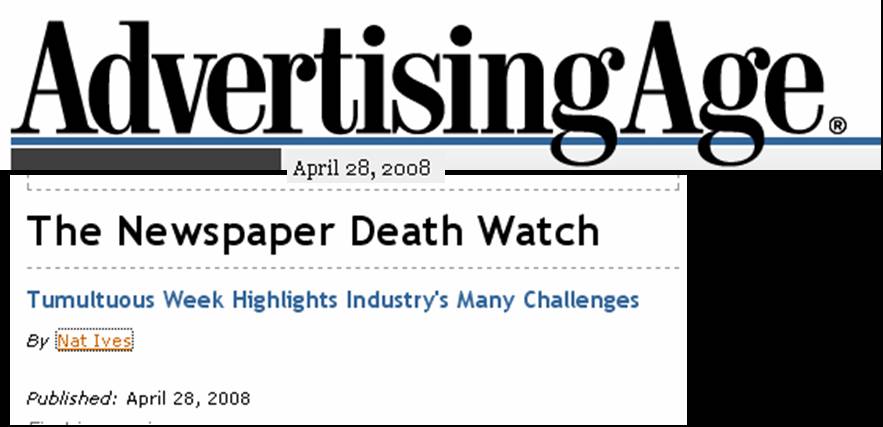Final Earnings Reports Trickle In
The Ontario-based publisher of the Toronto Star and dozens of community weeklies reported a $3.5 million loss on a 3.4% decline in revenue. A big factor in the swing from last year’s $15.7 million same-quarter profit was a $21 million restructuring charge associated with the elimination of 160 jobs at the flagship. Less than a month ago, news reports were marveling at the resilience of the Canadian newspaper market, but that optimism seems to have all but disappeared. The Globe and Mail says executives from other Canadian publishers like CanWest Global and Astral Media are also seeing rough times ahead.
American Community Newspapers (ACN), which publishes three dailies and 100 mostly free non-dailies, lost $4.5 million in the first quarter on an 11.7% revenue decline. It blamed the 44 papers in its Minneapolis/St. Paul cluster. More ominous was its statement that “for the second quarter of fiscal 2008 ACN does not expect to be in compliance with financial ratio covenants contained in its credit agreements.” In other words, it’s hoping creditors will be feeling generous, which isn’t too likely given the ugly state of the market since the Bear Stearns implosion.
Journal Register Co. will stop acting like a public company, even though it’ll still be publicly held. Beaten, bedraggled and delisted, the publisher of 21 dailies and 300 community papers said the cost of filing SEC reports and publishing shareholder communications just wasn’t worth it, in light of its stock being priced below that of a gumball. You’ll still be able to buy the stock on the Pink Sheets market, but you might just want to use the Pink Sheets to dispose of that wad of gum. Journal Register has applied for the necessary SEC exemptions.
Layoff Log
Fresh on the heels of a whopping 8.5% loss in daily circulation, the Atlanta Journal-Constitution said it’s cutting 62 positions and cutting back its distribution area from 74 to 49 counties. As recently as two years ago, the paper was distributed to 200 counties in five states.
Craig Smith says the Santa Barbara News-Press has laid off 16 people and names some names. He quotes a memo from the publishers saying that the Teamsters Union, which represents newsroom employees, has been doing things like calling people and urging them to cancel their subscriptions. One wonders how union members could think this would be constructive activity in the current environment. There’s no mention of total employment at the paper.
Where Will All the Dollars Go?
Respected market analyst Henry Blodgett speculates on Silicon Valley Insider about where $42 billion in newspaper advertising revenue will go. Describing a scenario that’s been outlined on this blog many times, he envisions a future in which circulation declines eventually reverse economies of scale and send newsapers into a tailspin. He adds that the green movement will pile on with its general distaste for anything on paper. Blodgett sees newspapers and their associated websites capturing maybe a third of those ad dollars, most of which will go online elsewhere. A spirited debate ensues in the comments section.
Department of Unintended Consequences
Washington City Paper analyzes the newspaper classified advertising business and finds that it is actually surprisingly healthy in the Beltway area. But the reason is that foreclosure notices have replaced “for sale” advertising as the engine of growth in the deflating real estate market . “On March 13, the Washington Post’s classifieds section totaled 22 pages, approximately 14 of which were devoted to what are technically known as ‘trustee’s sales,'” the website reports. This revenue is a legacy subsidy from area municipalities, which require foreclosure notices to be listed in local newspapers at several hundred dollars a pop. Which proves you can always find a silver lining.
 The oddmakers are still placing their bets on Rupert Murdoch to emerge from the Big Apple newspaper scrum clutching Newsday, but he apparently won’t get it without a fight. Newsday itself reports that
The oddmakers are still placing their bets on Rupert Murdoch to emerge from the Big Apple newspaper scrum clutching Newsday, but he apparently won’t get it without a fight. Newsday itself reports that 




